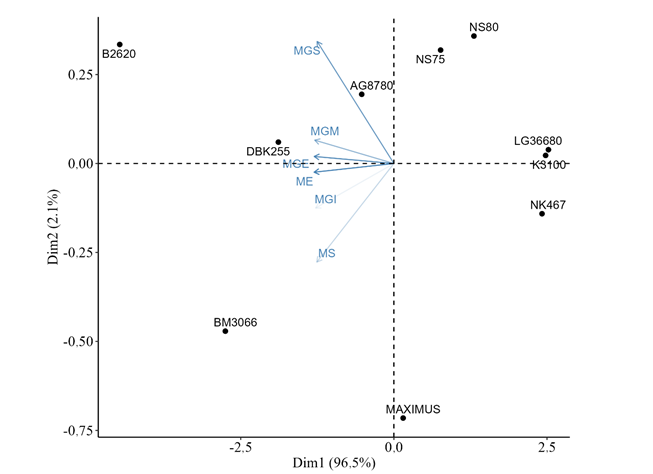Genetic divergence between single maize hybrids in relation to ear traits
Keywords:
Zea mays L., genetic variability, principal components, dendrogramAbstract
The objective of this work was to verify if there is genetic diversity between corn single hybrids for ear characters. An experiment was carried out in the agricultural year 2021/2022, in Santa Maria, State of Rio Grande do Sul, with ten single corn hybrids being evaluated (AG8780, B2620, BM3066, DKB255, K3100, LG36680, MAXIMUS, NK467, NS75 e NS80). Ten ears per hybrid were randomly collected to evaluate the weight, in grams, of the ear, the grains in the lower, middle and upper thirds of the ear, the grains on the ear and the cob. In order to understand the expression trends of the characters and highlight those that most contribute to the total variability, principal component analysis was used. Subsequently, the dissimilarity matrix between the hybrids was determined using the Euclidean distance and the clustering was performed using the UPGMA algorithm. The dendrogram was cut using as a criterion the large level change in the clustering distance, being observed in 53,65% of dissimilarity. There is genetic divergence between single maize hybrids for ear traits with formation of two groups. The masses, of the ear and grains of the ear, present a greater contribution to the genetic diversity.
References
ALVARES, C. A. et al. Köppen’s climate classification map for Brazil. Meteorologische Zeitschrift, v. 22, n. 6, p. 711-728, 2013.
ALVES, B. M. et al. Divergência genética de milho transgênico em relação à produtividade de grãos e à qualidade nutricional. Ciência Rural, v. 45, n. 5, p. 884-891, 2015.
BERTASELLO, L. E. T.; COELHO, A. P.; MÔRO, G. V. Divergência genética de genótipos de milho cultivados sob adubação nitrogenada e inoculação com Azospirillum brasilense. Revista Agroecossistemas, v. 12, n. 2, p. 69-89, 2020.
CARGNELUTTI FILHO, A.; GUADAGNIN, J. P. Consistência do padrão de agrupamento de cultivares de milho. Ciência Rural, v. 41, n. 9, p. 1503-1508, 2011.
CORDEIRO, A. G. M. Diversidade genética entre genótipos de milho (Zea mays L.) a partir de caracteres morfoagronômicos. Revista de Ciências Agroambientais, v. 19, n. 2, p. 125-131, 2021.
CRUZ, C. D.; CARNEIRO, P. C. S.; REGAZZI, A. J. Modelos biométricos aplicados ao melhoramento genético. 3.ed. Viçosa: Ed. UFV, 2014. v. 2, 668p.
FANCELLI, A. L.; DOURADO NETO, D. Milho: manejo e produtividade. Piracicaba: ESALQ/USP, 2009. 181 p.
JOLLIFFE, I. T.; CADIMA, J. Principal component analysis: a review and recent developments. Philosophical Transactions of the Royal Society A: Mathematical, Physical and Engineering Sciences, v. 374, p. 20150202, 2016.
R CORE TEAM. R: A Language and Environment for Statistical Computing. R Foundation
for Statistical Computing, Vienna, Austria, 2023. Disponível em: https://www.R-project.org/.
SANTOS, H. G. et al. Sistema brasileiro de classificação de solos. 5. ed. Rio de Janeiro: Embrapa, 2018.
SILVA, K. C. L. et al. Diversidade genética em genótipos de milho de plantio tardio sob diferentes níveis de nitrogênio no Tocantins. Revista de Agricultura Neotropical, v. 9, n. 3, p. 92-100, 2019.
SIMON, G. A.; KAMADA, T.; MOITEIRO, M. Divergência genética em milho de primeira e segunda safra. Semina: Ciências Agrárias, v. 33, n. 2, p. 449-458, 2012.

Downloads
Published
How to Cite
Issue
Section
License
Proposta de Política para Periódicos de Acesso Livre
Autores que publicam nesta revista concordam com os seguintes termos:
- Autores mantém os direitos autorais e concedem à revista o direito de primeira publicação, com o trabalho simultaneamente licenciado sob a Licença Creative Commons Attribution que permite o compartilhamento do trabalho com reconhecimento da autoria e publicação inicial nesta revista.
- Autores têm autorização para assumir contratos adicionais separadamente, para distribuição não-exclusiva da versão do trabalho publicada nesta revista (ex.: publicar em repositório institucional ou como capítulo de livro), com reconhecimento de autoria e publicação inicial nesta revista.
- Autores têm permissão e são estimulados a publicar e distribuir seu trabalho online (ex.: em repositórios institucionais ou na sua página pessoal) a qualquer ponto antes ou durante o processo editorial, já que isso pode gerar alterações produtivas, bem como aumentar o impacto e a citação do trabalho publicado (Veja O Efeito do Acesso Livre).



